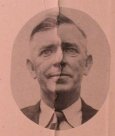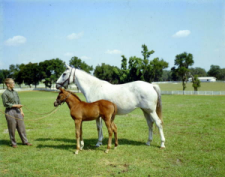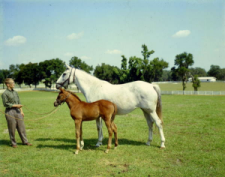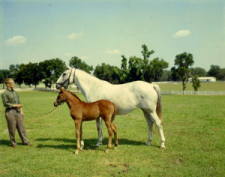Photographs document history in a special way. And as we collect them, they complement our family papers, providing a visual link to the past.
Photography was developed in France and England in the 1840s. Although the materials have changed over the years, the basic components of a photographic print have generally remained the same. A photographic print consists of a base material coated with a light sensitive emulsion. The earliest form of photographic print, the daguerreotype, used a copper sheet coated with silver. Many Civil War photos were ambrotypes, which utilized glass as the base and a syrupy liquid called collodion as the emulsion. Another early type of photograph, the albumen print, had paper as the base and egg whites and salt comprising the emulsion.
For more information on the history photography development, visit our Daguerreotype to Digital page at our Photo Exhibits page.
 |
Most photographs have all the problems of paper, plus the added problems of dyes and emulsions. |
Modern photographic prints tend to have a paper base and gelatin emulsion. Black and white photographs use silver or platinum particles floating in the emulsion to form the actual picture. Due to the qualities of these metals, black and white photographs have the potential to last many years. Color photographic prints have three layers of emulsion, one for each of three colors – yellow, cyan (blue/green) and magenta. Unfortunately, the dyes for color photographs are not stable, and color photographs do not last as long as black and white.
|
Following is a discussion of preservation suggestions to extend the life of traditional photographs, both black and white and color. For information on film, prints and digital photograph printers for pictures that will last, see "Starting out right - choosing the media for your purpose."
Traditional Photography
A number of things can be done to help to extend the life of photographs, both black and white and color.
Negatives and slides
Keep your negatives. These are the originals of your photograph, and from them, prints can repeatedly be made.
Slides and negatives can be stored in either polyester sleeves or acid free paper envelopes. There are storage enclosures made specifically for them. Neither slides nor negatives have a paper base, so they do not have the same acids inherent in them as do prints with a paper base. However, they can be affected to some extent by the same things that affect prints. Use the same storage and handling guidelines for your slides and negatives as you do for your prints.
Environment
Temperature and humidity are both very important considerations when storing photographs. Hot, moist air encourages the growth of mold on both the paper and the emulsion. Heat can affect the paper on which the photograph is printed, making it brown and brittle. High humidity can affect the dyes in color photographs, making them change hue. Changes in temperature and humidity will cause photographs to expand and contract. Because paper expands and contracts at a different rate than does the emulsion, changes in temperature and humidity can lead to cracking and curling photographs.
Attics are poor storage areas for photographs, as they tend to be very hot in the summer and very cold in the winter. Basements are also poor storage areas for photographs, as they tend to be damp and moldy. Other poor storage areas are those that contain a washer and dryer or machinery that gives off heat, and areas directly above air conditioning units or heat vents. Cool and dry conditions are the best for photographs slowing the acidic reaction and discouraging mold growth. Florida temperatures and humidity make it hard to reach the optimal storage levels of 50º Fahrenheit and 35% humidity. Negatives also require a cool, dry storage environment. A small refrigerator, used only for negative storage, is one option.
In hot, humid conditions, good ventilation provides a cooling effect and inhibits mold from attaching to photographs. To facilitate air flow and filter the air in your photograph area, use a high efficiency filter such as a HEPA filter. HEPA filters are available at local hardware and department stores.
HEPA filters can take pollutants, mold, and dust out of the air. Dust particles can scratch photographic negatives, which will affect any prints made from them. Dust also can scratch slides and the emulsion on prints. Pollutants, such as sulfur dioxide from car exhaust, will also damage photographs. Sulfur dioxide, when mixed with water (humidity), creates sulfuric acid, which can eat away at photographic emulsions.
Keep food and drink away from photographs. Crumbs and sticky spots attract bugs to paper. Liquids can distort the gelatin emulsion and can stain photographs permanently.
Photographs are extremely sensitive to light. Avoid direct light sources. Florescent lights and sunlight contain harmful ultraviolet rays that will fade photographs. Light sources also can give off heat. Store photographs in boxes or albums and out of bright lighting and sunlight. Try to place framed photographs out of direct lighting.
Storage
Store photographs, slides and negatives in acid free boxes. Acids from inferior paper boxes (like shoe boxes) can migrate onto your photographs, making them brown and brittle. A well-fitting acid free box can help to keep photographs from curling, even in Florida's hot, humid climate. Storing the photographs in acid free envelopes or folders will help even more. Do not store the photographs "face to face," as emulsions will easily stick together on humid days and will be difficult to separate.
The dyes in color photographs can be affected by the alkaline buffering in paper. If you store color photographs, slides, or negatives in paper envelopes or sleeves, check to see that the enclosures are un-buffered.
Display photographs in albums made to open flat, and with polyester display sleeves or acid free pages. Magnetic albums and albums with vinyl sleeves are very bad for photographs: the adhesive which makes an album “magnetic” is acidic; and vinyl deteriorates, affecting the emulsion of the photographs as it does so. Many photograph albums come with decorative paper backing. Check to see that the paper is acid free, lignin free and pH neutral. For more information on paper, see “ Buzzwords in the Archival Industry.”
When buying storage or display materials for photographs, be sure they have passed the PAT. “PAT” stands for Photograph Activity Test. While many manufacturers advertise that their product is “Photo Safe,” this is not the same as having passed the Photograph Activity Test. The term “Photo Safe” has no standards applied to it and has become a buzzword in the commercial scrapbook and family heirloom markets. The PAT was developed in conjunction with the American National Standards Institute (ANSI), and products which have passed the PAT must conform to very high standards. If the product has not passed the PAT, it is not “photo safe.”
Another display and storage option is preservation matting and framing. This method is used by museums when they display photographs, which can then be stored in their mats. Please see "How to mat a piece of art" for more information.
Scrapbooking is an interesting and vibrant way to display photographs, but it is not the best way to store them. Use copies of your photographs in your scrapbooks, rather than the originals. Keep the originals, especially the negatives, in storage containers which have passed the PAT, and know that they are safe. For more information on archival scrapbooking, see "Making Archival Scrapbooks."
For information on where to purchase storage materials and albums, please see Conservation On-Line.
Handling
Hold photographs and negatives by the edge. Avoid touching the emulsion surface with your fingers, as your fingerprints can become a permanent part of the surface.
Labeling photographs is very important, to ensure an accurate record. Identifying people by their names and relationships, and noting the date, place, event, and photographer for each image, will help future generations to understand them. When labeling, use a soft pencil on the edge of the back of the photograph. Many inks are not as permanent as pencil, and ball point pens can push through the back, creating bumps in the emulsion. Another method is to label the enclosure, rather than the photograph. Label the folder or envelope, or buy album sleeves which have areas for labeling of photographs.
Pressure sensitive tapes such as “magic tape” or “masking tape” have acidic adhesives. They will turn yellow, and will turn the paper yellow as well, before falling off and leaving behind a sticky residue. Although it is best not to use any sort of tape on photographs, there is no very good home alternative for fixing a torn photo. If the negative is still available making a new print is the best bet. If it is not available, and the photograph is very valuable and old it might be worthwhile to consult a conservator. If this is not feasible, there are some types of “archival quality” tapes available at art supply or scrapbook stores. Look for tapes that are acid free, made with acrylic adhesive, and have passed the PAT. When applying tape to any tear, keep in mind the following tips:
- Always tape the back of a photograph - never apply any glue or tape to the emulsion.
- Use the least amount of tape you can possibly use to mend the tear (i.e. don’t use a 6 inch strip to cover a three inch tear).
- If possible, snip a small bits of tape from the roll and tack the tear together. Once the photograph is tacked together, it can then have a new negative made from it. This will ensure that it will last longer than the tape that is holding it together.
An alternative to using tape is to make your own mending strip with a piece of acid free paper, and some acid free white glue. Apply a thin coating of glue to a thin strip of paper, gently press the strip into place on the back of the photograph, and wipe away the excess glue with a cotton swab. Place the photograph face down on a soft, flat surface and dry it under weight. A good weight for mending photographs is a small candy tin filled with BBs. Thoroughly wash and dry the box before filling it, then tape it shut so the BBs won't fall out if you drop the box.
Do not use paper clips, rubber bands, or even plastic clips on photographs.
Scanning photographs has become very popular and is a good idea for dissemination. However, it is not necessarily a permanent solution for preservation of photographs. Scanning photographs creates into digital images, which cannot be seen without aid of a computer or other device unless printed out. There have been some advances in the printers, inks, and papers used to print digital photographs. For more discussion on these, please read the Digital Photographs section of "Starting out right - choosing the media for your purpose."
When framing photographs, use acid free mat board and acid free backing. Humidity can cause emulsions to stick to glass, so keep a bit of space between the photograph and the glass by using a mat, or even a double mat. Humidity can cause emulsions to stick to glass. For more information on framing, please see “Preservation Matting and Framing Overview ." For information on Display of photographs, see: "Hanging and Display of Works of Art and Photographs."






